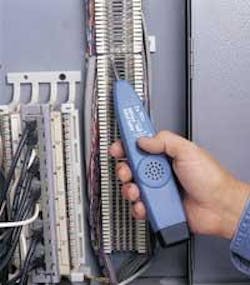Probing the challenges of cable-tracing tools
High-density connection points require highly capable toners and probes.
The cabling industry’s general trend toward higher density of terminations has been lauded on many fronts, particularly as a means of allowing more networking ports per unit of rack space than ever before. Whether it is a conventional commercial-building cabling setup with a single backbone riser and intermediate crossconnects on each floor, or a data-center environment that is infamous for the density of its patching fields, chances are that any telecom space is more tightly packed with connections now than it was a few years ago.
While that congestion of cables has great benefits in the way of saving real estate, it has also created challenges for technicians handling the cables, while terminating, carrying out regular system maintenance, and troubleshooting. Take a look through the catalog of any connecting-hardware manufacturer and, along with patch panels, you are sure to find cable-management rings, troughs, and other accessories intended specifically for termination spaces. Such products are popular and necessary because of the sheer number of cables present in a rack-based termination environment.
Another product line affected by the growing prominence of high-density termination spaces is the tone generator/probe combination (See table of products, page 40). “Locating cable in a bundle due to signal bleed from cable to cable, differentiating the tone from noise or a false signal, finding a signal due to active network connections-these things are problematic if not impossible” for much of today’s tone-and-probe equipment, says Dan Klimke, marketing manager for Fluke Networks’ Network Tools product line.
Put simply, the toner and probe are used in tandem to trace a single copper-based (twisted-pair or coaxial) cable among a bundle or cluster of cables. The tone generator does just what its name indicates, sending tone down the circuit that the technician is trying to identify. The technician then uses the probe, often a wandlike device, to detect the signal injected by the generator-and by doing so, finding the target cable.
Tandem tracers
The tone generator and probe combination is perhaps the most fundamental testing tool and is sure to be present in every technician’s toolkit, with a street price most often well below $200. Yet that does not mean the tools are commodities, or that they have fully matured in their technological development. To the contrary, users of this equipment need it to be more advanced and capable than ever, in part because of the heavily congested termination fields noted earlier. Click here to view Toners & Probes Product Update.
Troubleshooting tones
Transitions and steady trends
PATRICK McLAUGHLIN is chief editor of Cabling Installation & Maintenance.


